A Method of Precise Auto-Calibration in a Micro-Electro-Mechanical System Accelerometer
Abstract
:1. Introduction
2. The Mechanical Design of the Accelerometer
3. The Principle of Auto-Calibration
- a—the measured acceleration;
- U—the output voltage resulting from the instantaneous value of the capacitance of the differential capacitor consisting of plates P1, P2, and P3;
- O—the offset (bias) of the output voltage expressed in Volts [V];
- S—the scale factor of the output voltage expressed in Volts per g [V/g];
- g—gravitational acceleration (about 10 m/s2).
3.1. Pre-Calibration of Specific Acceleration
3.2. Post-Calibration of Accelerometer
- When the indication U2 of the accelerometer, corresponding to the coverage of the E1 and E3 electrodes, is recorded, as shown in Figure 1, and the indication U1 of the accelerometer, corresponding to the coverage of the E1 and E2 electrodes, is recorded, as shown in Figure 2a, the following is true:
- b.
- When the indication U2 of the accelerometer, corresponding to the coverage of the E1 and E3 electrodes, is recorded, as shown in Figure 1, Equation (2) is true, and then the indication U3 of the accelerometer, corresponding to the coverage of the E1 and E4 electrodes, is recorded as follows, as shown in Figure 2b:
- c.
4. The Electronic Structure of the Accelerometer
5. Simulation Study
5.1. The Mechanical Structure of the Accelerometer
5.2. Simulations of the Mechanical Behavior of the Seismic Mass
5.3. Simulations of the Tunneling Current Transducer
6. Discussion
6.1. Amplitude Attenuation and Phase-Shift over Frequency
6.2. The Thermal Stability of the Stiffness of the Elastic Suspension
6.3. Tunneling Current Transducers
6.4. Multiaxial Accelerometers
6.5. Alternative Versions of the Accelerometer
6.5.1. A Higher Number of Detectors
6.5.2. A Lower Number of Detectors
6.5.3. Different Locations of Detectors
6.5.4. Different Kinds of Detectors
6.6. The Fabrication Cost of the Accelerometer
7. Summary
8. Patents
Author Contributions
Funding
Data Availability Statement
Acknowledgments
Conflicts of Interest
References
- Łuczak, S.; Grepl, R.; Bodnicki, M. Selection of MEMS Accelerometers for Tilt Measurements. J. Sens. 2017, 2017, 9796146. [Google Scholar] [CrossRef]
- Martínez, J.; Asiain, D.; Beltrán, J.R. Lightweight Thermal Compensation Technique for MEMS Capacitive Accelerometer Oriented to Quasi-Static Measurements. Sensors 2021, 21, 3117. [Google Scholar] [CrossRef] [PubMed]
- Aggarwal, P.; Syed, Z.; Noureldin, A.; El-Sheimy, N. MEMS-Based Integrated Navigation; Artech House Inc.: Boston, MA, USA; London, UK, 2010; p. 11. [Google Scholar]
- Kaajakari, V. Practical MEMS; Small Gear Publishing: Las Vegas, NV, USA, 2009. [Google Scholar]
- Łuczak, S.; Wierciak, J.; Credo, W. Effects of natural aging in biaxial MEMS accelerometers. IEEE Sens. J. 2021, 21, 9171352. [Google Scholar] [CrossRef]
- Ruzza, G.; Guerriero, L.; Revellino, P.; Guadagno, F.M. A Low-Cost Chamber Prototype for Automatic Thermal Analysis of MEMS IMU Sensors in Tilt Measurements Perspective. Sensors 2019, 19, 2705. [Google Scholar] [CrossRef]
- Clark, J. Self-Calibration and Performance Control of MEMS with Applications for IoT. Sensors 2018, 18, 4411. [Google Scholar] [CrossRef]
- Farago, D.; Maczak, B.; Gingl, Z. Enhancing Accuracy in Actigraphic Measurements: A Lightweight Calibration Method for Triaxial Accelerometers. IEEE Access 2024, 12, 38102–38111. [Google Scholar] [CrossRef]
- Dürr, O.; Fan, P.-Y.; Yin, Z.-X. Bayesian Calibration of MEMS Accelerometers. IEEE Sens. J. 2023, 23, 13319–13326. [Google Scholar] [CrossRef]
- Pedersini, F. Dynamic Calibration of Triaxial Accelerometers with Simple Setup. IEEE Sens. J. 2022, 22, 9665–9674. [Google Scholar] [CrossRef]
- Lin, C. High-Precision Calibration Method of Inclinometer for Coal Mine Based on Improved Ellipsoid Fitting. In Proceedings of the 2023 5th International Conference on Intelligent Control, Measurement and Signal Processing (ICMSP), Chengdu, China, 19–21 May 2023; pp. 825–828. [Google Scholar] [CrossRef]
- Natori, T.; Aikawa, N. Study on Calibration Method using Pseudo Acceleration for MEMS Accelerometers. In Proceedings of the 2023 12th International Conference on Modern Circuits and Systems Technologies (MOCAST), Athens, Greece, 28–30 June 2023; pp. 1–4. [Google Scholar] [CrossRef]
- Ru, X.; Gu, N.; Shang, H.; Zhang, H. MEMS Inertial Sensor Calibration Technology: Current Status and Future Trends. Micromachines 2022, 13, 879. [Google Scholar] [CrossRef]
- Shi, L.-F.; Liu, Y.-Y. Three-Step Autonomous Calibration Method for Low-Cost MEMS Inertial/Magnetic Sensors. IEEE Trans. Magn. 2022, 58, 4002112. [Google Scholar] [CrossRef]
- Sun, Z.; Wang, M. Self-Test and Self-Calibration of Digital Closed-Loop Accelerometers. Sensors 2022, 22, 9933. [Google Scholar] [CrossRef] [PubMed]
- Łuczak, S.; Zams, M.; Dąbrowski, B.; Kusznierewicz, Z. Tilt Sensor with Recalibration Feature Based on MEMS Accelerometer. Sensors 2022, 22, 1504. [Google Scholar] [CrossRef] [PubMed]
- Acar, C.; Shkel, A. Experimental evaluation and comparative analysis of commercial variable-capacitance MEMS accelerometers. J. Micromech. Microeng. 2003, 13, 634–645. [Google Scholar] [CrossRef]
- Łuczak, S. Experimental Studies of Hysteresis in MEMS Accelerometers: A Commentary. IEEE Sens. J. 2015, 15, 3492–3499. [Google Scholar] [CrossRef]
- Stančin, S.; Tomažič, S. Time- and Computation-Efficient Calibration of MEMS 3D Accelerometers and Gyroscopes. Sensors 2014, 14, 14885–14915. [Google Scholar] [CrossRef] [PubMed]
- Elsts, A.; McConville, R. Are Microcontrollers Ready for Deep Learning-Based Human Activity Recognition? Electronics 2021, 10, 2640. [Google Scholar] [CrossRef]
- Mekruksavanich, S.; Jitpattanakul, A. Deep Convolutional Neural Network with RNNs for Complex Activity Recognition Using Wrist-Worn Wearable Sensor Data. Electronics 2021, 10, 1685. [Google Scholar] [CrossRef]
- Pires, I.M.; Ponciano, V.; Garcia, N.M.; Zdravevski, E. Analysis of the Results of Heel-Rise Test with Sensors: A Systematic Review. Electronics 2020, 9, 1154. [Google Scholar] [CrossRef]
- Collado-Villaverde, A.; Cobos, M.; Muñoz, P.; Barrero, D.F. A Simulator to Support Machine Learning-Based Wearable Fall Detection Systems. Electronics 2020, 9, 1831. [Google Scholar] [CrossRef]
- Lötters, J.C.; Schipper, J.; Veltink, P.H.; Olthuis, W.; Bergveld, P. Procedure for in-use calibration of triaxial accelerometers in medical applications. Sens. Actuators 1998, A68, 221–228. [Google Scholar] [CrossRef]
- Frosio, I.; Pedersini, F.; Borghese, N.A. Autocalibration of Triaxial MEMS Accelerometers with Automatic Sensor Model Selection. IEEE Sens. J. 2012, 12, 2100–2108. [Google Scholar] [CrossRef]
- Šipoš, M.; Pačes, P.; Roháč, J.; Novacek, P. Analyses of triaxial accelerometer calibration algorithms. IEEE Sens. J. 2012, 12, 1157–1165. [Google Scholar] [CrossRef]
- Olivares, A.; Ruiz-Garcia, G.; Olivares, G.; Górriz, J.M.; Ramirez, J. Automatic Determination of Validity of Input Data Used in Ellipsoid Fitting MARG Calibration Algorithms. Sensors 2013, 13, 11797–11817. [Google Scholar] [CrossRef] [PubMed]
- Syed, Z.; Aggarwal, P.; Goodall, C.; Niu, X.; El-Sheimy, N. A new multi-position calibration method for MEMS inertial navigation systems. Meas. Sci. Technol. 2007, 18, 1897–1907. [Google Scholar] [CrossRef]
- Won, S.P.; Golnaraghi, F. A Triaxial Accelerometer Calibration Method Using a Mathematical Model. IEEE Trans. Instrum. Meas. 2010, 59, 2144–2153. [Google Scholar] [CrossRef]
- Ren, C.; Liu, Q.; Fu, T. A novel self-calibration method for MIMU. IEEE Sens. J. 2015, 15, 5416–5422. [Google Scholar] [CrossRef]
- Qureshi, U.; Golnaraghi, F. An algorithm for the in-field calibration of a MEMS IMU. IEEE Sensors J. 2017, 17, 7479–7486. [Google Scholar] [CrossRef]
- Chan, L.; Yuan, C.; Zhi-jian, D.; Hong, C. New self-calibration schemes for accelerometers of platform. In Proceedings of the 26th Chinese Control and Decision Conference, Changsha, China, 31 May–2 June 2014; Volume 26, pp. 1032–1042. [Google Scholar]
- Nemec, D.; Janota, A.; Hrubos, M.; Simak, V. Intelligent real-time MEMS sensor fusion and calibration. IEEE Sens. J. 2016, 16, 7150–7160. [Google Scholar] [CrossRef]
- Beravs, T.; Podobnik, J.; Munih, M. Three-axial accelerometer calibration using Kalman filter covariance matrix for online estimation of optimal sensor orientation. IEEE Trans. Instrum. Meas. 2012, 61, 2501–2511. [Google Scholar] [CrossRef]
- Programmable Dual-Axis Inclinometer/Accelerometer ADIS 16201, Datasheet, Analog Devices Inc., Norwood, MA, USA. 2006. Available online: https://www.analog.com/media/en/technical-documentation/data-sheets/ADIS16201.pdf (accessed on 4 May 2021).
- Reducing Accelerometer Temperature Drift with Crystal Ovens. Sensors 1996, 13, 92.
- Yang, D.; Woo, J.K.; Lee, S.; Mitchell, J.; Challoner, A.D.; Najafi, K. A micro oven-control system for inertial sensors. J. Microelectromech. Syst. 2017, 26, 507–518. [Google Scholar] [CrossRef]
- Precision ±1.7g Single/Dual Axis Accelerometer ADXL 103/ADXL 203, Analog Devices Inc., Norwood, MA, USA. 2005. Available online: https://www.analog.com/media/en/technical-documentation/data-sheets/ADXL103_203.pdf (accessed on 4 May 2021).
- Miao, M.; Hu, Q.; Hao, Y.; Dong, H.; Wang, L.; Shi, Y.; Shen, S. A Bulk Micromachined Si-on-glass Tunneling Accelerometer with Out-of-plane Sensing Capability. In Proceedings of the 2007 2nd IEEE International Conference on Nano/Micro Engineered and Molecular Systems, Bangkok, Thailand, 16–19 January 2007; pp. 235–240. [Google Scholar] [CrossRef]
- Zhu, L.; McNamara, S. Low Power Tunneling Current Strain Sensor Using MOS Capacitors. J. Microelectromech. Syst. 2015, 24, 755–762. [Google Scholar] [CrossRef]
- Liu, C.H.; Kenny, T.W. A high-precision, wide-bandwidth micromachined tunneling accelerometer. J. Microelectromech. Syst. 2001, 10, 425–433. [Google Scholar] [CrossRef]
- Kenny, T.W.; Kaiser, W.J.; Rockstad, H.K.; Reynolds, J.K.; Podosek, J.A.; Vote, E.C. Wide-bandwidth electromechanical actuators for tunneling displacement transducers. J. Microelectromech. Syst. 1994, 3, 97–104. [Google Scholar] [CrossRef]
- Yeh, C.; Najafi, K. Micromachined tunneling accelerometer with a low-voltage CMOS interface circuit. In Proceedings of the International Solid State Sensors and Actuators Conference (Transducers’97), Chicago, IL, USA, 16–19 July 1997; IEEE Inc.: Piscataway, NJ, USA, 1997; Volume 2, pp. 1213–1216. [Google Scholar] [CrossRef]
- Liu, C.H.; Barzilai, A.M.; Reynolds, J.K.; Partridge, A.; Kenny, T.W.; Grade, J.D.; Rockstad, H.K. Characterization of a high-sensitivity micromachined tunneling accelerometer with micro-g resolution. J. Microelectromech Syst. 1998, 7, 235–244. [Google Scholar] [CrossRef]
- Beißner, S.; Puppich, M.; Bütefisch, S.; Büttgenbach, S.; Elbel, T. Analog Force Feedback Circuit for Capacitive Micromechanical Acceleration Sensors. In Proceedings of the 10th International Conference Sensor 2001, Nuremberg, Germany, 8–10 May 2001; Volume 2, pp. 577–582. [Google Scholar]
- Weinberg, H. Dual Axis, Low g, Fully Integrated Accelerometers. Analog. Dialogue 1999, 33, 1. Available online: https://www.analog.com/en/analog-dialogue/articles/dual-axis-low-g-fully-integrated-accelerometers.html (accessed on 5 July 2023).
- High Accuracy ±1 g to ±5 g Single Axis iMEMS Accelerometer with Analog Input, ADXL 105. Analog Devices, Inc., Norwood, MA, USA. 1999. Available online: https://www.analog.com/media/en/technical-documentation/obsolete-data-sheets/ADXL105.pdf (accessed on 4 May 2021).
- Ravariu, C.; Mihaiescu, D.E.; Manea, E.; Parvulescu, C.A. Nothing on Insulator-NOI-Nanotransistor Configuration Suitable for the Zaidman Model. In Proceedings of the 2018 20th International Symposium on Electrical Apparatus and Technologies (SIELA), Bourgas, Bulgaria, 3–6 June 2018; pp. 1–4. [Google Scholar] [CrossRef]
- Liu, Z.; Cai, C.; Yang, M.; Zhang, Y. Testing of a MEMS Dynamic Inclinometer Using the Stewart Platform. Sensors 2019, 19, 4233. [Google Scholar] [CrossRef]
- Maillard, P.; The Silicon Revolution. Europa Star Time.Keeper 2008, August. Available online: https://www.europastar.com/watch-knowledge/1003843153-the-silicon-revolution.html (accessed on 4 May 2021).
- Low-Cost ±2 g Dual Axis Accelerometer with Digital Output, ADXL 202E. Analog Devices, Inc., Norwood, MA, USA. 2000. Available online: http://www.analog.com/media/en/technical-documentation/data-sheets/ADXL202E.pdf (accessed on 4 May 2021).
- Łuczak, S. Tilt Measurements in BMW Motorcycles. In Recent Global Research and Education: Technological Challenges; Jabłoński, R., Szewczyk, R., Eds.; Springer International Publishing: Cham, Switzerland, 2017; pp. 287–293. [Google Scholar]
- Lorenc, Z.; Paśko, S.; Kursa, O.; Pakuła, A.; Sałbut, L. Spectral technique for detection of changes in eggshells caused by Mycoplasma synoviae. Poultry Sci. 2019, 98, 3481–3487. [Google Scholar] [CrossRef]
- Łuczak, S. MEMS Accelerometer with Precision Auto-Calibration Function (Akcelerometr Typu MEMS z Możliwością Precyzyjnej Auto-Kalibracji). Patent 244583, 13 November 2023. (In Polish). [Google Scholar]
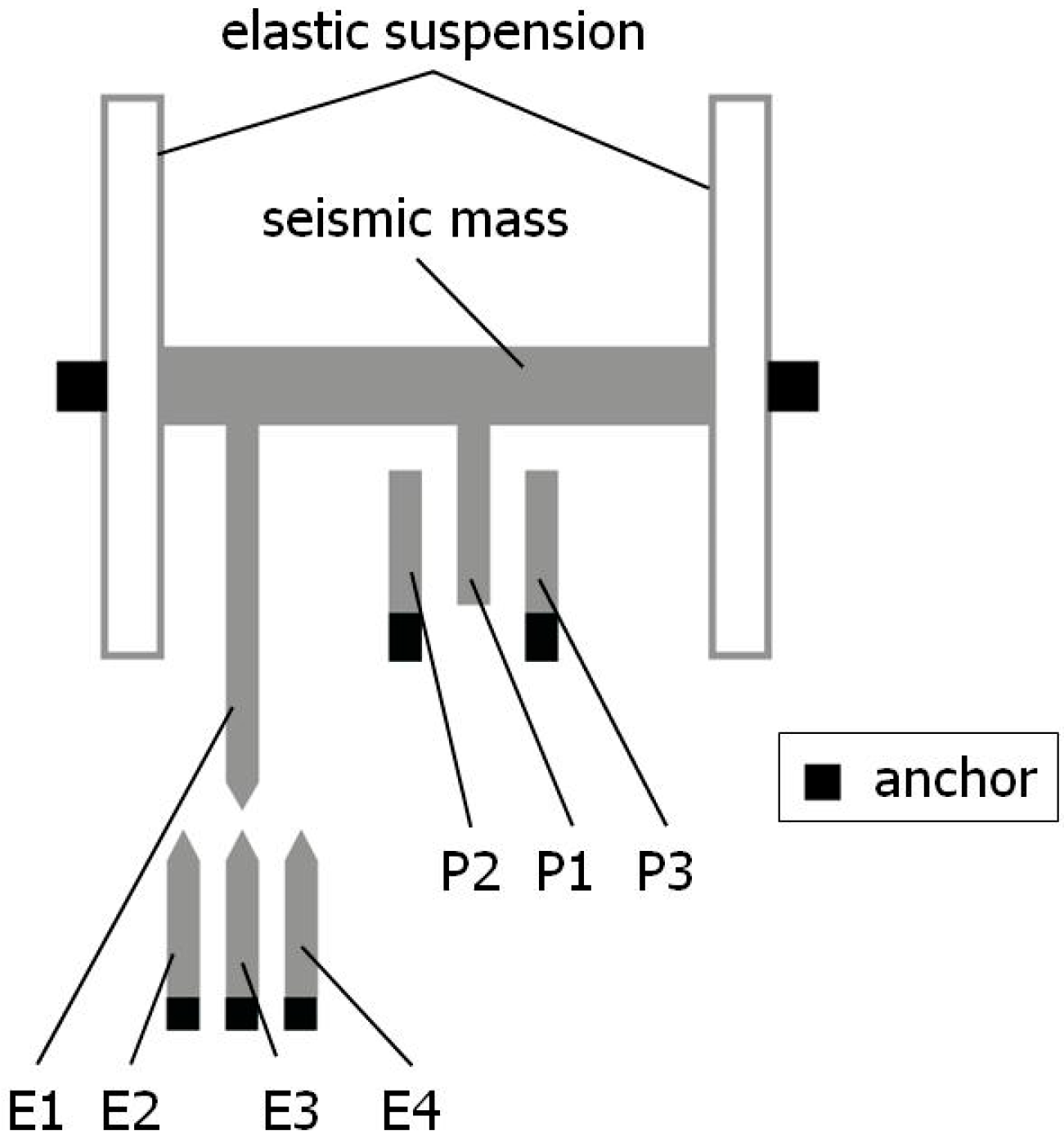


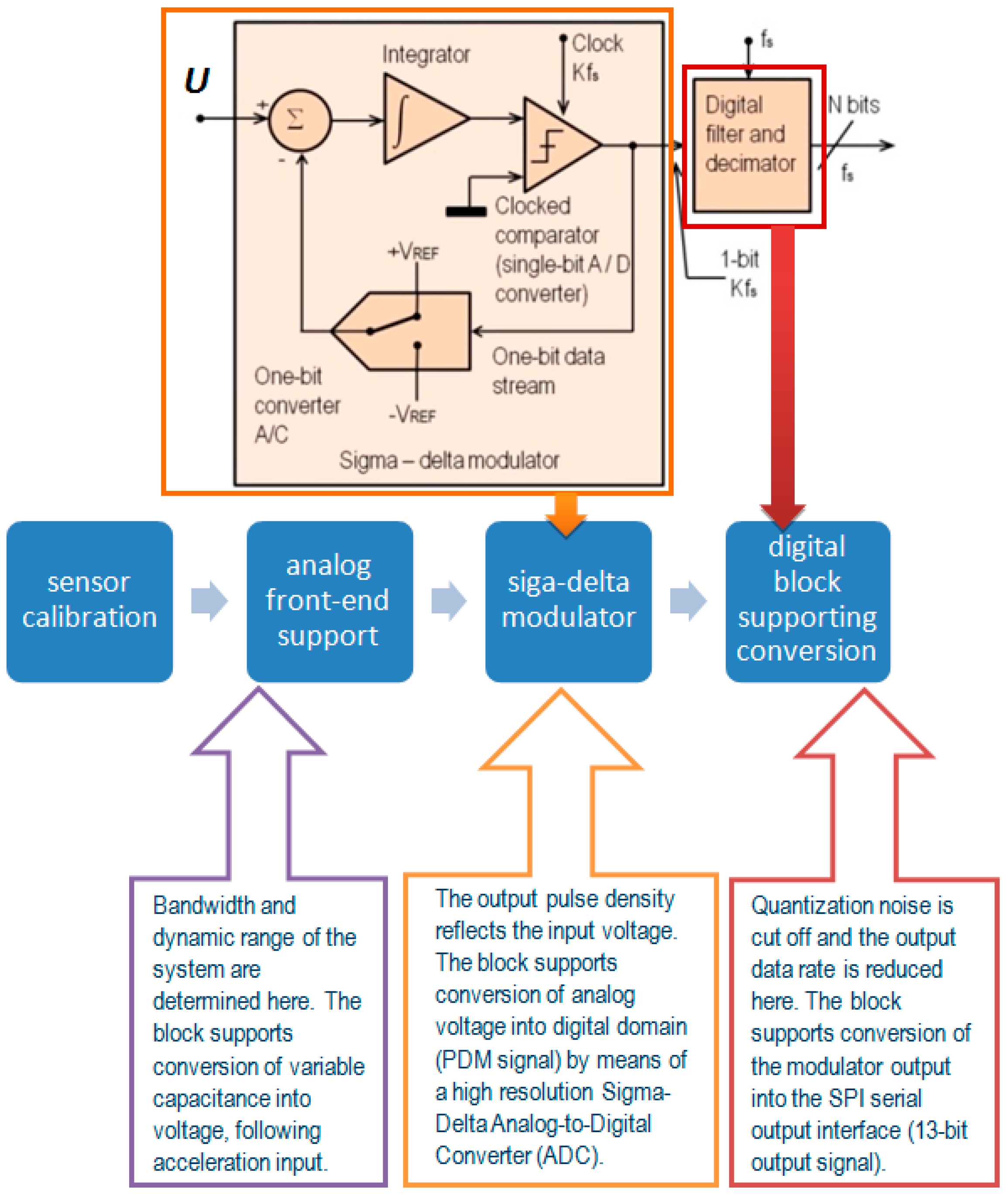



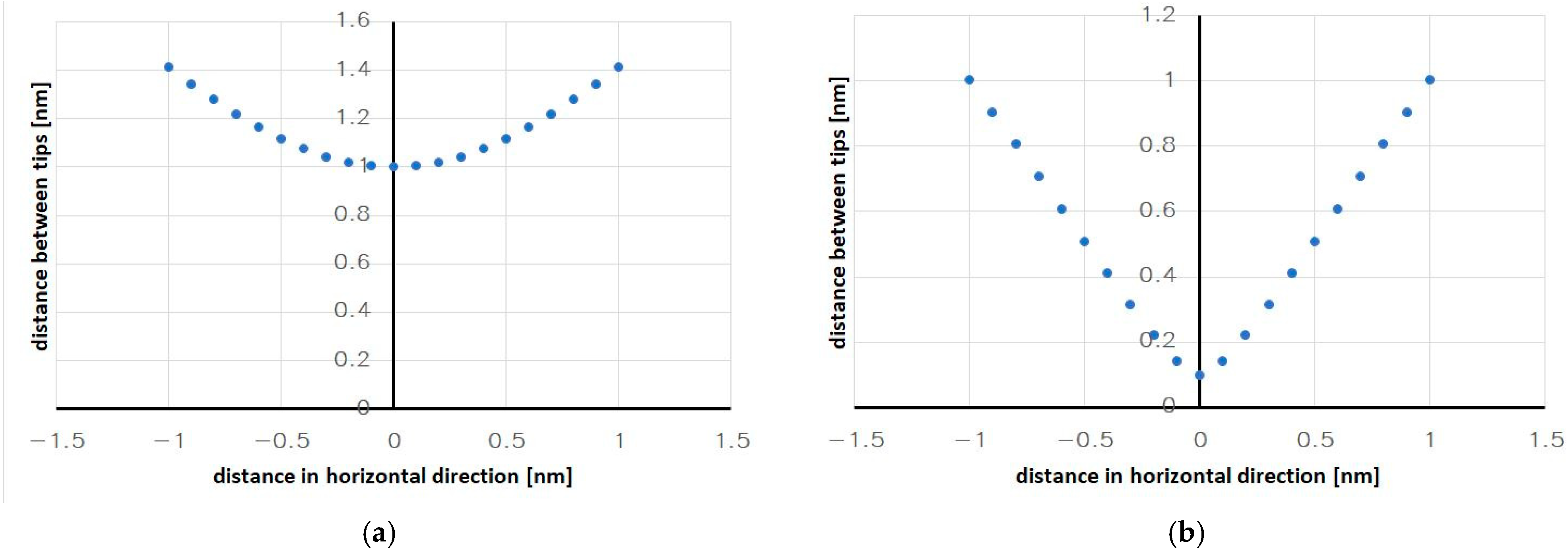
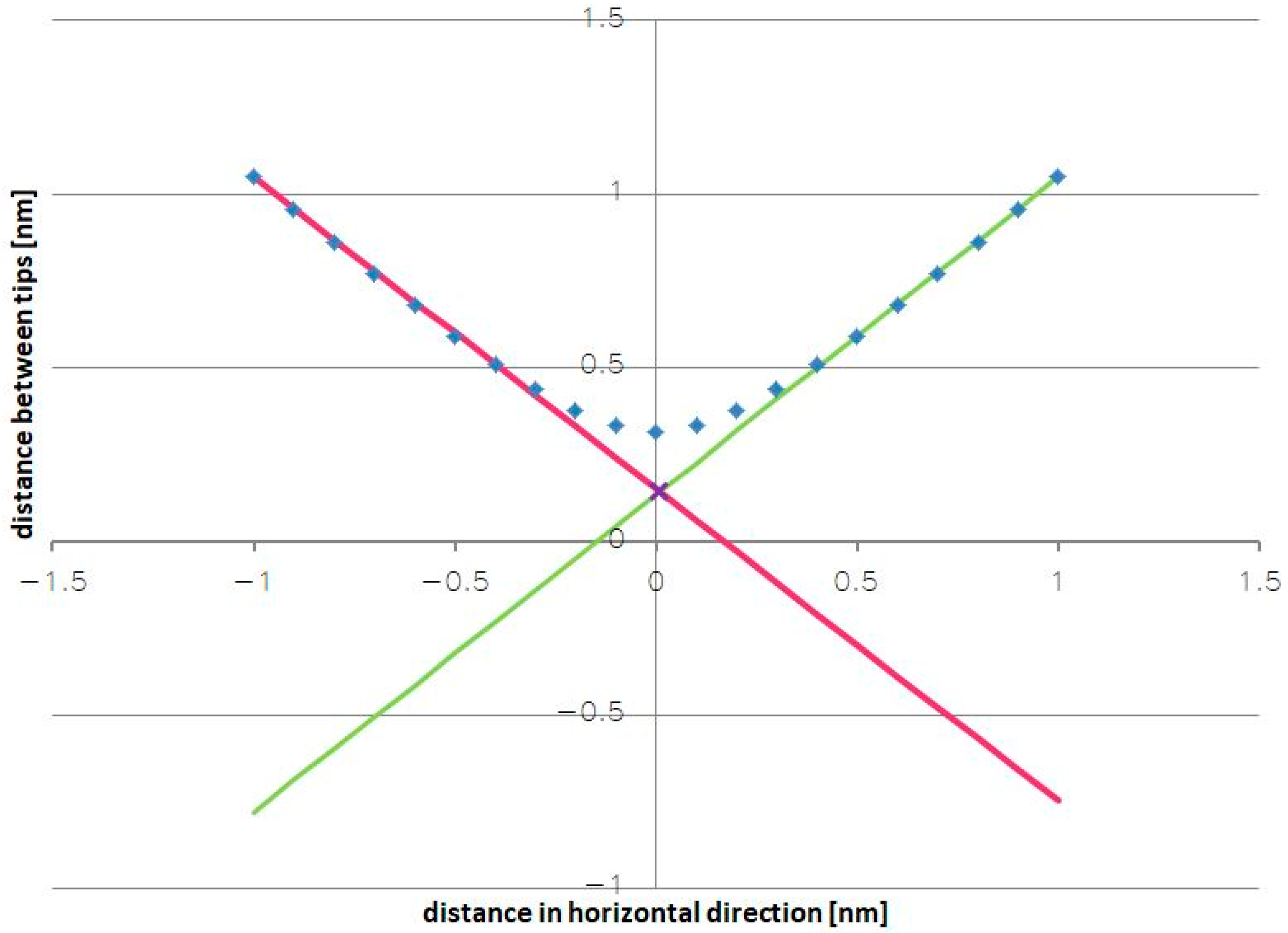
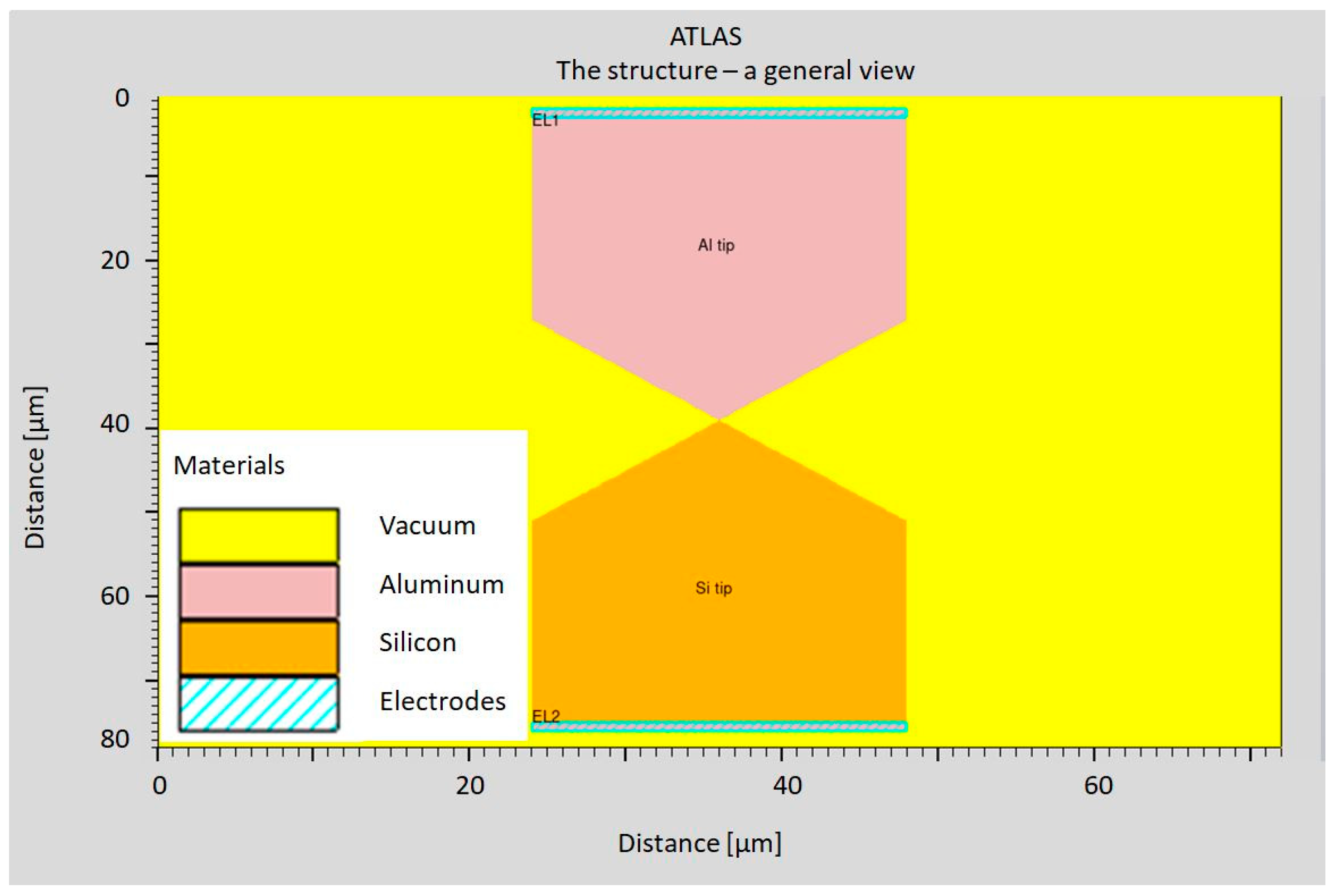
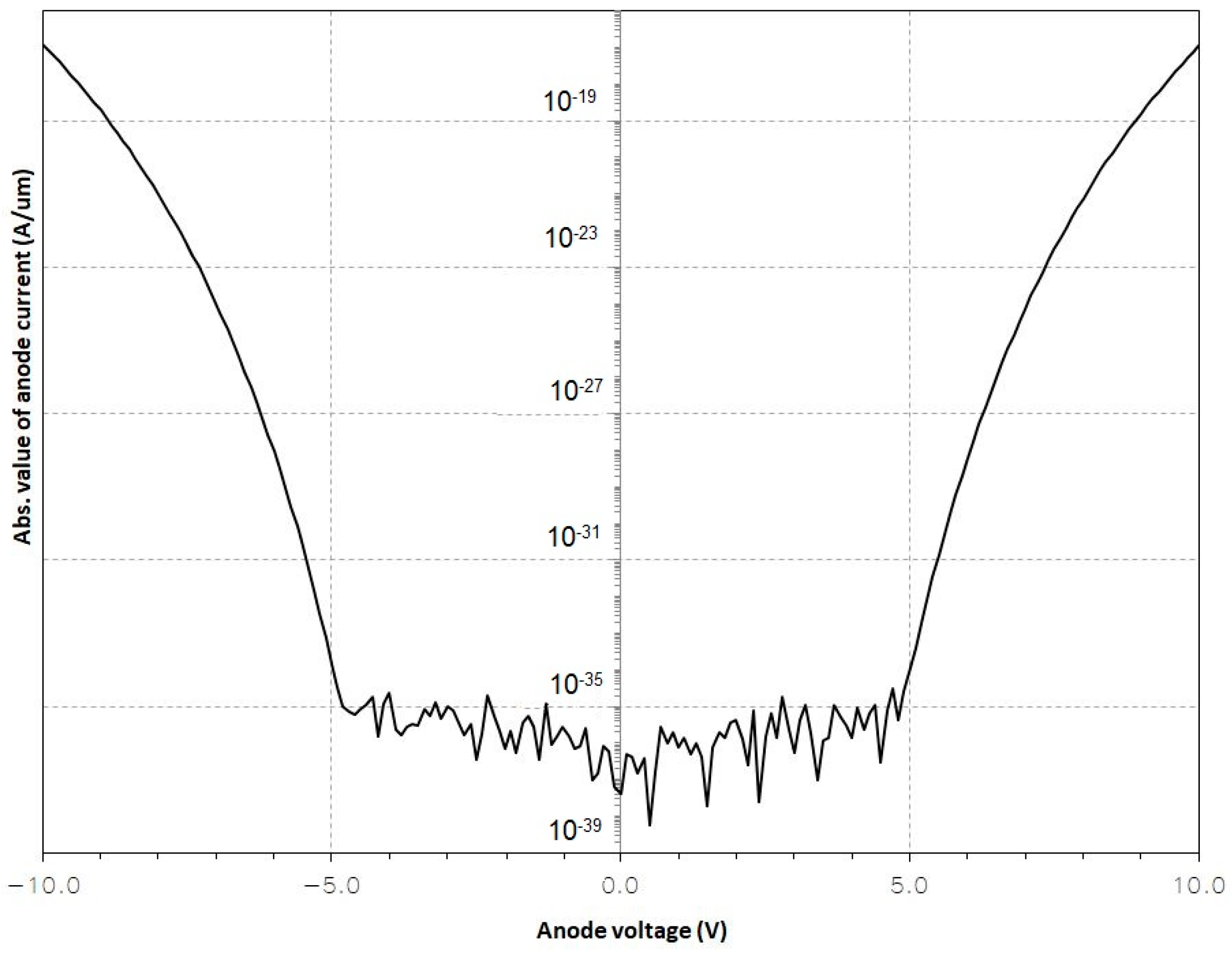
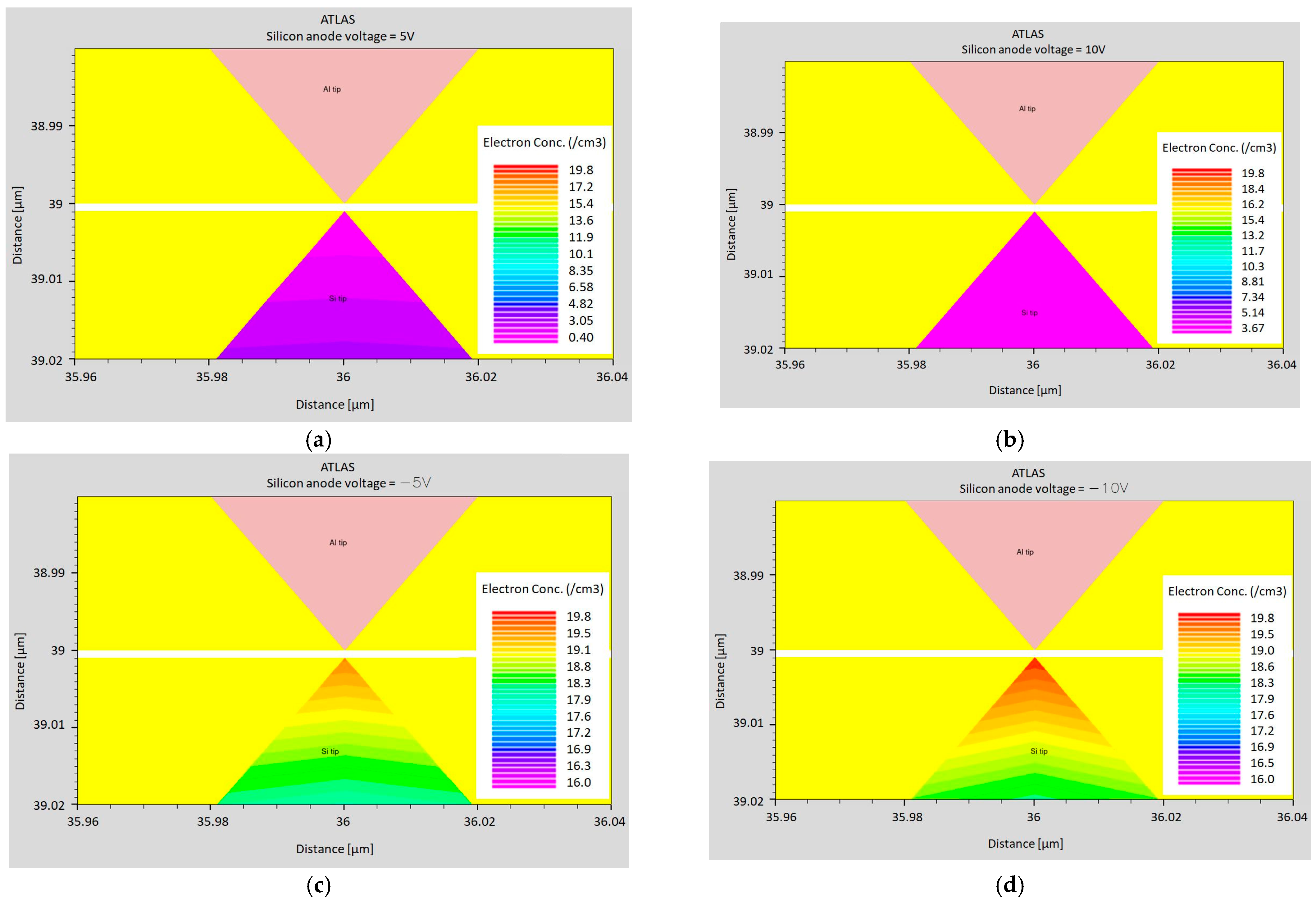
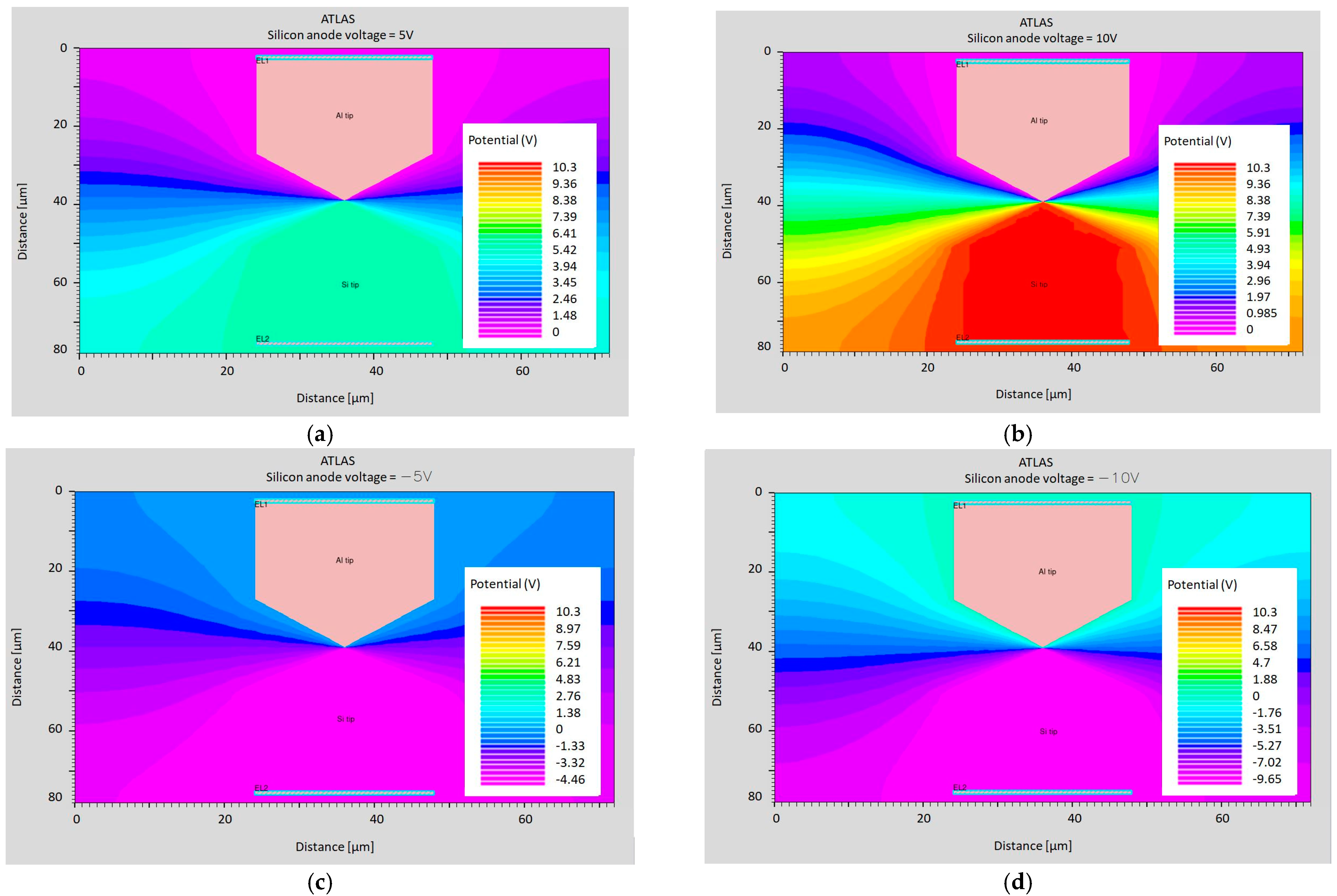
| Voltage | Maximal Distance | Charge |
|---|---|---|
| [V] | [nm] | [fC] |
| 20 | 2.50 | 0.354 |
| 15 | 1.40 | 0.266 |
| 14 | 1.20 | 0.248 |
| 13 | 1.00 | 0.23 |
| 10 | 0.62 | 0.177 |
| Acceleration | Displacement |
|---|---|
| [m/s2] | [nm] |
| 0.5 | 0.054 |
| 1 | 0.120 |
| 1.5 | 0.160 |
| 2 | 0.220 |
Disclaimer/Publisher’s Note: The statements, opinions and data contained in all publications are solely those of the individual author(s) and contributor(s) and not of MDPI and/or the editor(s). MDPI and/or the editor(s) disclaim responsibility for any injury to people or property resulting from any ideas, methods, instructions or products referred to in the content. |
© 2024 by the authors. Licensee MDPI, Basel, Switzerland. This article is an open access article distributed under the terms and conditions of the Creative Commons Attribution (CC BY) license (https://creativecommons.org/licenses/by/4.0/).
Share and Cite
Łuczak, S.; Ekwińska, M.; Tomaszewski, D. A Method of Precise Auto-Calibration in a Micro-Electro-Mechanical System Accelerometer. Sensors 2024, 24, 4018. https://doi.org/10.3390/s24124018
Łuczak S, Ekwińska M, Tomaszewski D. A Method of Precise Auto-Calibration in a Micro-Electro-Mechanical System Accelerometer. Sensors. 2024; 24(12):4018. https://doi.org/10.3390/s24124018
Chicago/Turabian StyleŁuczak, Sergiusz, Magdalena Ekwińska, and Daniel Tomaszewski. 2024. "A Method of Precise Auto-Calibration in a Micro-Electro-Mechanical System Accelerometer" Sensors 24, no. 12: 4018. https://doi.org/10.3390/s24124018







